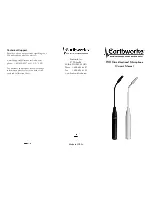
Appendix 2
Evolution of an Icon
1932 RCA-44A to the 2008 AEA A-440
The oldest piece of pro audio equipment still in regular use is the RCA 44. A revolutionary microphone
design, it became the standard of reference for live sound, broadcast, film sound, and recording. It was
developed when audio tests were difficult and critical listening was crucial to the process. More than
70 years later, the 44B and BXs are still first rank microphones used daily in music, voice, broadcast
and cinema applications.
Dr. Harry Olson is credited as the inventor of the ribbon microphone. He adapted the concept of the
ribbon loudspeaker, invented in 1924 by Erwin Gerlach, by reversing the transduction process. He
realized one could use a conductive ribbon lightly suspended in a transverse magnetic field, as either
a speaker or a microphone. That insight led him to develop of the first high-performance directional
microphone in the world, the bi-directional 44A.
The 1932 RCA model 44A was Olson’s first commercial success. “Two major characteristics of this
type of microphone are particularly attractive from the standpoint of high fidelity sound reproduction,
namely a uniform response frequency characteristic over the entire audio frequency range and a uni-
form directivity pattern over the entire audio frequency range. The ribbon-type velocity microphone
was the first wide-frequency-range and high-quality microphone which exhibited a uniform directivity
pattern over the entire audio frequency range.” (Olson, Journal of the Audio Engineering Society, June
1970)
The rapid advancement of permanent magnet technology in the 1930s had freed Olson’s ribbon micro-
phones from the constraints of using an electromagnet. The 44 had an accurate full-bandwidth figure-
eight pattern, a transparent wide-range sound, excellent dynamics, required no external power, and was
immune to humidity. These characteristics made the audio engineer’s job much easier, and set a stan-
dard to which others aspired.
The 44A was soon joined by the 77A, the first cardioid microphone. The 44A was replaced in 1936 by
the 44B which had more output and a gorgeous black and silver Art Deco case. The 1938 BX revision
kept the 44B’s high-output, double Alnico magnet design, but had a less reflective umber finish suitable
for the newly emerging medium of television. The 44BX remained in production until the mid 1950s.
In the mid 1970s RCA ceased all microphone production. However both the 44B and BX and its cous-
ins the RCA-77D and DX remain in continuous use in recording studios and on scoring stages.
As magnetic tape became the dominant media for recording, ribbon microphones fell out of favor.
Magnetic recording with its greater linearity and dynamic range solved many disc and optical re-
cording problems and pioneers such as Les Paul and the Beatles became quite creative with multi-
generational magnetic recording. However there was always a slight loss of highs from generation to
generation. Large capsule condenser microphones helped resolve this problem as they have a number
of high-Q resonances in the 8 to 12 K Hz range. The treble ‘tizz’ this imparts became popular, because
after a couple of transfers these recordings sounded just right on the radio or juke box.








































